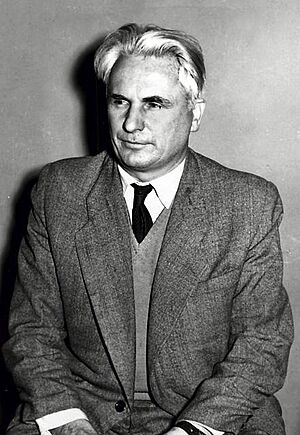Edward Osóbka-Morawski facts for kids
Quick facts for kids
Edward Osóbka-Morawski
|
|
|---|---|

Osóbka-Morawski in 1944
|
|
| 1st Prime Minister of Polish People's Republic | |
| In office 31 December 1944 – 5 February 1947 |
|
| President | Bolesław Bierut |
| Deputy | Stanisław Janusz Władysław Gomułka Stanisław Mikołajczyk |
| Preceded by | Felicjan Sławoj Składkowski (As Prime Minister of the Second Polish Republic) Tomasz Arciszewski (As Prime Minister in exile) |
| Succeeded by | Józef Cyrankiewicz |
| Personal details | |
| Born | 5 October 1909 Bliżyn, Congress Poland, Russian Empire |
| Died | 9 January 1997 (aged 87) Warsaw, Poland |
| Political party | Polish Socialist Party (before 1948) Polish United Workers Party (1948–1949, 1956–1990) |
Edward Bolesław Osóbka-Morawski ['edvart ɔˈsupka mɔˈrafskʲi] (5 October 1909 – 9 January 1997) was a Polish activist and politician in the Polish Socialist Party (PPS) before World War II, and after the Soviet takeover of Poland, Chairman of the Communist-dominated interim government, the Polish Committee of National Liberation (Polski Komitet Wyzwolenia Narodowego) formed in Lublin with Stalin's approval.
In October 1944, Osóbka-Morawski was given the role of Minister of Foreign Affairs and Agriculture. Several months later, in June 1945, he was appointed Prime Minister of the Provisional Government of National Unity (Tymczasowy Rząd Jedności Narodowej), in office until February 1947. Osóbka-Morawski believed the PPS should join with the other non-communist party in Poland, the Polish Peasant Party, to form a united front against the Communist Polish Workers' Party. However, another prominent socialist, Józef Cyrankiewicz argued that the PPS should support the communists while opposing the creation of a one-party state. The Communists, with Soviet support, played on this division and forced Osóbka-Morawski to resign in favour of Cyrankiewicz.
Osóbka-Morawski would make his peace with the Communists, and gradually became a Stalinist. Nonetheless, in 1949 he was dismissed from his new post as the Minister of Public Administration, for "deviationist" tendencies. He was readmitted to the Communist Party, now called the Polish United Workers' Party, during the Polish October revolution of 1956. He then worked as a party official throughout most of his life in the People's Republic of Poland prior to the Revolutions of 1989, and in 1990 failed in his attempt to recreate the old Polish Socialist Party. He died in Warsaw in 1997.
See also
- Stalinism in Poland
- Socialist realism in Poland

